Feasibility Study of Carbon Dioxide Plume Geothermal Systems in Germany−Utilising Carbon Dioxide for Energy
Abstract
1. Introduction
2. Data Requirements and Calculation Methods
2.1. Geological Setting
2.2. CO2 Plume Geothermal System (CPG)
2.3. Carbon Dioxide Capture
2.4. Transportation and Injection
2.5. Economic Calculation
3. Risk Assessment
4. Results and Discussion
5. Future Work and Considerations
6. Conclusions
Author Contributions
Funding
Conflicts of Interest
Nomenclature
| EGS | Enhanced geothermal system |
| EOR | Enhanced oil recovery |
| g | Grams |
| IGCC | Integrated gasification combined cycle |
| CO2 | Carbon dioxide |
| CO2-ECBM | Carbon dioxide enhanced coalbed methane |
| CPG | Carbon dioxide plume geothermal |
| kg | Kilograms |
| km | Kilometre |
| kW | Kilowatt |
| kWh | Kilowatt hour |
| LCA | Life cycle assessment |
| LCOE | Levelized cost of electricity |
| m | Meter |
| MD | Measured depth |
| MEA | Monoethanolamine |
| MPa | Megapascal |
| MW | Megawatt |
| MWe | Megawatt electricity |
| MWh | Megawatt hour |
| MWth | Megawatt thermal |
| NGCC | Natural gas combined cycle |
| Pcr | Critical pressure |
| ROI | Return on investment |
| s | Second |
| t | Metric tonnes |
| T | Temperature |
| Tcr | Critical temperature |
| ρ | Density |
References
- Directive 2012/27/EU of the European Parliament and of the Council of 25 October 2012 on Energy Efficiency, Amending Directives 2009/125/EC and 2010/30/EU and Repealing Directives 2004/8/EC and 2006/32/EC. Available online: http://eur-lex.europa.eu/legal-content/EN/TXT/PDF/?uri=CELEX:32012L0027&from=EN (accessed on 10 March 2018).
- EC 2030 Climate and Energy Policy Framework. Communication from the Commission to the European Parliament, the Council, the European Economic and Social Committee and the Committee of the Regions—A Policy Framework for Climate and Energy in the Period from 2020 to 2030. 2014. Available online: http://eur-lex.europa.eu/legal-content/EN/TXT/PDF/?uri=CELEX:52014DC0015&-from=EN (accessed on 19 March 2018).
- German Federal Ministry for Economic Affairs and Energy (EEG). Renewable Energy Source Act. 2017. Available online: http://www.bmwi.de/Redaktion/EN/Downloads/rene-wable-energy-sources-act-2017.pdf?__blob=publicationFile&v=3 (accessed on 22 March 2018).
- Eurostat. Energy Balance Sheets European Commission—Eurostat. 2017. Available online: http://dx.doi.org/10.2785/032728 (accessed on 15 March 2018).
- Matthes, F. Exit economics: The relatively low cost of Germany’s nuclear phase-out. Bull. At. Sci. 2012, 68, 42–54. [Google Scholar] [CrossRef]
- Kunz, F.; Weigt, H. Germany’s Nuclear Phase Out: A Survey of the Impact since 2011 and Outlook to 2023. Econ. Energy Environ. Policy 2014, 3, 13–27. [Google Scholar] [CrossRef][Green Version]
- Larson, A. Trianel Coal Power Plant, Lünen, North Rhine – Westphalia. Power 2014, 158, 34–35. [Google Scholar]
- IRENA (International Renewable Energy Agency). Final Renewable Energy Consumption (2016 Data). Available online: http://resourceirena.irena.org/gateway/dashboard/?topic=18&subTopic=47 (accessed on 26 July 2018).
- Mines, G.; Richard, C.; Nathwani, J.; Hanson, H.; Wood, R. Geothermal Plant Capacity Factors. In Proceedings of the Fortieth Workshop on Geothermal Reservoir Engineering, Stanford, CA, USA, 26–28 January 2015. [Google Scholar]
- Sanyal, S.K. Cost of Geothermal Power and Factors that affect it. In Proceedings of the Twenty-Ninth Workshop on Geothermal Reservoir Engineering, Stanford, CA, USA, 26–28 January 2004. [Google Scholar]
- Sanyal, S.K. Cost of Electric Power from Enhanced Geothermal Systems—Its Sensitivity and Optimization. Trans. Geotherm. Resour. Counc. 2009, 33, 221–225. [Google Scholar]
- Menberg, K.; Pfister, S.; Blum, P.; Bayer, P. A matter of meters: State of the art in the life cycle assessment of enhanced geothermal systems. Energy Environ. Sci. 2016, 9, 2720. [Google Scholar] [CrossRef]
- Pratiwi, A.; Ravier, G.; Genter, A. Life-cycle climate-change impact assessment of enhanced geothermal system plants in the Upper Rhine Valley. Geothermics 2018, 75, 26–39. [Google Scholar] [CrossRef]
- Barbier, E. Geothermal energy technology and current status: An overview. Renew. Sustain. Energy Rev. 2002, 6, 3–65. [Google Scholar] [CrossRef]
- Johnston, I.W.; Narsilio, G.A.; Colls, S. Emerging Geothermal Energy Technologies. KSCE J. Civ. Eng. 2011, 15, 643–653. [Google Scholar] [CrossRef]
- Randolph, J.B.; Saar, M.O. Combining geothermal energy capture with geologic carbon dioxide sequestration. Geophys. Res. Lett. 2011, 38. [Google Scholar] [CrossRef]
- IPCC. IPCC Special Report on Carbon Dioxide Capture and Storage; Prepared by Working Group III of the Intergovernmental Panel on Climate Change; Metz, B., Davidson, O., de Coninck, H.C., Loos, M., Meyer, L.A., Eds.; Cambridge University Press: Cambridge, UK; New York, NY, USA, 2005; 442p. [Google Scholar]
- International Energy Agency (IEA). CO2 CAPTURE and STORAGE a Key Carbon Abatement Option. 2008. Available online: https://www.iea.org/publications/freepublications/publication/CCS_2008.pdf (accessed on 15 June 2018).
- European Commission. Implementation of Directive 2009/31/EC on the Geological Storage of Carbon Dioxide. 2011. Available online: https://ec.europa.eu/clima/sites/clima/files/lowcarbon/ccs/implementation/docs/gd1_en.pdf (accessed on 20 June 2018).
- Randolph, J.B.; Saar, M.O. Coupling carbon dioxide sequestration with geothermal energy capture in naturally permeable, porous geologic formations: Implications for CO2 sequestration. Energy Procedia 2011, 4, 2206–2213. [Google Scholar] [CrossRef]
- Garapati, N.; Randolph, J.B.; Valencia, J.L.; Saar, M.O. CO2-Plume Geothermal (CPG) Heat Extraction in Multi-layered Geologic Reservoirs. Energy Procedia 2014, 63, 7631–7643. [Google Scholar] [CrossRef]
- Pruess, K. The TOUGH codes-a family of simulation tools for multiphase flow and transport processes in permeable media. Vadose Zone J. 2004, 3, 738–746. [Google Scholar] [CrossRef]
- Pruess, K. Enhanced geothermal systems (EGS) using CO2 as working fluid-a novel approach for generating renewable energy with simultaneous sequestration of carbon. Geothermics 2008, 35, 351–367. [Google Scholar] [CrossRef]
- Pioro, I.; Mokry, S. Thermophysical properties at critical and supercritical pressures. In Heat Transfer - Theoretical Analysis, Experimental Investigations and Industrial Systems; Belmiloudi, A., Ed.; IntechOpen Ltd.: London UK, 28 January 2011; ISBN 978-953-307-226-5. [Google Scholar]
- Zhang, F.Z.; Jiang, P.X.; Xu, R.N. System thermodynamic performance comparison of CO2-EGS and water-EGS systems. Appl. Therm. Eng. 2013, 61, 236–244. [Google Scholar] [CrossRef]
- Liu, J.; Suna, L.; Wub, X.; Yao, J. Feasibility of combination of CO2 geological storage with geothermal-type water-soluble gas recovery in Yinggehai Basin, China. Int. J. Greenh. Gas Control 2016, 45, 139–149. [Google Scholar] [CrossRef]
- Seibt, P.; Kabus, F.; Hoth, P. The Neustadt-Glewe Geothermal Power Plant – Practical Experience in the Reinjection of Cooled Thermal Waters into Sandstone Aquifers. In Proceedings of the World Geothermal Congress, Antalya, Turkey, 24–29 April 2005. [Google Scholar]
- Weber, J.; Ganz, B.; Schellschmidt, R.; Sanner, B.; Schulz, R. Geothermal Energy Use in Germany. In Proceedings of the World Geothermal Congress, Melbourne, Australia, 19–25 April 2015; Available online: https://pangea.stanford.edu/ERE/db/WGC/papers/WGC-/2015/-01045.pdf (accessed on 23 June 2018).
- Routledge, K.; Williams, J. District heating - Heat metering Cost Benefit Analysis. Heat Strategy & Policy Department of Energy and Climate Change, Building Research Establishment Ltd.; 2012. Available online: https://assets.publishing.service.gov.uk/government/uploads/system/uploads/attachment_data/file/48389/5462-district-heating--heat-metering-cost-benefit-anal.pdf (accessed on 30 July 2018).
- Lüschen, E.; Wolfgramm, M.; Fritzer, T.; Dussel, M.; Thomas, R.; Schulz, R. 3D seismic survey explores geothermal targets for reservoir characterization at Unterhaching, Munich, Germany. Geothermics 2014, 50, 167–179. [Google Scholar] [CrossRef]
- Homuth, S.; Gütz, A.E.; Sass, I. Reservoir characterization of the Upper Jurassic geothermal target formations (Molasse Basin, Germany): Role of thermofacies as exploration tool. Geother. Energy Sci. 2015, 3, 41–49. [Google Scholar] [CrossRef]
- Aretz, A.; Bär, K.; Götz, A.E.; Sass, I. Outcrop analogue study of Permocarboniferous geothermal sandstone reservoir formations (northern Upper Rhine Graben, Germany): Impact of mineral content, depositional environment and diagenesis on petrophysical properties. Int. J. Earth Sci. (Geol. Rundsch) 2016, 105, 1431–1452. [Google Scholar] [CrossRef]
- Van Alphen, K.; van Ruijven, J.; Kasa, S.; Hekkert, M.; Turkenburg, W. The performance of the Norwegian carbon dioxide, capture and storage innovation system. Energy Policy 2009, 37, 43–55. [Google Scholar] [CrossRef]
- Leung, D.Y.C.; Caramanna, G.; Maroto-Valer, M.M. An overview of current status of carbon dioxide capture and storage technologies. Renew. Sustain. Energy Rev. 2014, 39, 426–443. [Google Scholar] [CrossRef]
- Leach, A.; Mason, C.F.; van’t Veld, K. Co-optimization of enhanced oil recovery and carbon sequestration. Resour. Energy Econ. 2011, 33, 893–912. [Google Scholar] [CrossRef]
- Muggeridge, A.; Cockin, A.; Webb, K.; Frampton, H.; Collins, I.; Moulds, T.; Salino, P. Recovery rates, enhanced oil recovery and technological limits. Philos. Trans. Math. Phys. Eng. Sci. 2014, 372, 1–25. [Google Scholar] [CrossRef] [PubMed]
- Godec, M.; Koperna, G.; Gale, J. CO2-ECBM: A Review of its Status and Global Potential. Energy Procedia 2014, 63, 5858–5869. [Google Scholar] [CrossRef]
- Bachu, S.; Bonijoly, D.; Bradshaw, J.; Burrus, R.; Holloway, S.; Christensen, N.P.; Mathiassen, O.M. CO2 storage capacity estimation: Methodology and gaps. Int. J. Greenh. Gas Control 2007, 1, 430–443. [Google Scholar] [CrossRef]
- Cheah, W.Y.; Ling, T.C.; Show, P.L.; Juan, J.C.; Chang, J.-S.; Lee, D.-J. Cultivation in wastewaters for energy: A microalgae platform. Appl. Energy 2016, 179, 609–625, ISSN 0306-2619. [Google Scholar] [CrossRef]
- Song, J.; Ren, X.; Li, X.; Gu, C.; Zhang, M. One-dimensional model analysis and performance assessment of Tesla turbine. Appl. Therm. Eng. 2018, 134, 546–554. [Google Scholar] [CrossRef]
- Manfrida, G.; Pacini, L.; Talluri, L. An upgraded Tesla turbine concept for ORC applications. Energy 2018, 158, 33–40. [Google Scholar] [CrossRef]
- Olivier, J.G.J.; Janssens-Maenhout, G.; Muntean, M.; Peters, J.A.H.W. Trends in Global CO2 Emissions: 2016 Report; PBL Netherlands Environmental Assessment Agency: The Hague, Netherlands, 2016; Available online: http://edgar.jrc.ec.europa.eu/news_docs/jrc-2016-trends-in-global-co2-emissions-2016-report-103425.pdf (accessed on 5 August 2019).
- International Energy Agency (IEA). Power Generation from Coal Measuring and Reporting Efficiency Performance and CO2 Emissions s.n. S.l. 2010. Available online: https://www.iea.org/ciab/papers/power_generation_from_coal.pdf (accessed on 15 June 2018).
- D’Amore, F.; Bezzo, F. Economic optimisation of European supply chains for CO2 capture, transport and sequestration. Int. J. Greenh. Gas Control 2017, 65, 99–116. [Google Scholar]
- Ramezan, M.; Skone, J.T.; Nsakala, Y.N.; Liljedahl, N.G. Carbon Dioxide Capture from Existing Coal-Fired Power Plants. Available online: https://www.globalccsinstitute.com/archive/hub/publications/159713/carbon-dioxide-capture-existing-coal-fired-power-plants.pdf (accessed on 15 December 2019).
- Liu, H.; Hou, Z.; Were, P.; Sun, X.; Gou, Y. Numerical studies on CO2 injection–brine extraction process in a low-medium temperature reservoir system. Environ. Earth Sci. 2015, 73, 6839–6854. [Google Scholar] [CrossRef]
- Kemp, A.G.; Kasim, A.S. A Least-Cost Optimisation Model of CO2 Capture Applied to Major UK Power Plants Within The EU-ETS Framework. Energy J. 2008, 29, 99–134. [Google Scholar] [CrossRef]
- Bayer, U.; Scheck, M.; Rabbel, W.; Krawczyk, C.M.; Götze, H.-J.; Stiller, M.; Beilecke, T.; Marotta, A.-M.; Barrio-Alvers, L.; Kuder, J. An integrated study of the NE German Basin. Tectonophysics 1999, 314, 285–307. [Google Scholar] [CrossRef]
- Becker, I.; Wüstefeld, P.; Koehrer, B.; Felder, M.; Hilgers, C. Porosity and Permeability variations in a tight gas sandstone reservoir analogue, Westphalian D, Lower Saxony Basin, NW Germany: Influence of Depositional setting and diagenesis. J. Pet. Geol. 2017, 40, 363–390. [Google Scholar] [CrossRef]
- Von Pasternak, M. Exploration and production of crude oil and natural gas in Germany in 2011. Erdöl Erdgas Kohle 2012, 129, 260–273. [Google Scholar]
- Desbois, G.; Urai, J.L.; Hemes, S.; Schröppel, B.; Schwarz, J.-O.; Mac, M.; Weiel, D. Multi-scale analysis of porosity in diagenetically altered reservoir sandstone from the Permian Rotliegend (Germany). J. Pet. Sci. Eng. 2016, 140, 128–148. [Google Scholar] [CrossRef]
- Schill, E.; Genter, A.; Cuenot, N.; Kohl, T. Hydraulic performance history at the Soultz EGS reservoirs from stimulation and long-term circulation tests. Geothermics 2017, 70, 110–124. [Google Scholar] [CrossRef]
- Busch, A.; Bertier, P.; Gensterblum, Y.; Rother, G.; Spiers, C.J.; Zhang, M.; Wentinck, H.M. On sorption and swelling of CO2 in clays. Geomech. Geophys. Geo-Energy Geo-Resour. 2016, 2, 111–130. [Google Scholar] [CrossRef]
- Markewitz, P.; Kuckshinrichs, W.; Leitner, W.; Linssen, J.; Zapp, P.; Bongartz, R.; Schreiber, A.; Müller, T.E. Worldwide innovations in the development of carbon capture technologies and the utilization of CO2. Energy Environ. Sci. 2012, 5, 7281. [Google Scholar] [CrossRef]
- Goeppert, A.; Czaun, M.; Prakash, S.G.K.; Olah, G.A. Air as the renewable carbon source of the future: An overview of CO2 capture from the atmosphere. Energy Environ. Sci. 2012, 5, 7833. [Google Scholar] [CrossRef]
- Vasterling, M.; Wegler, U.; Becker, J.; Brüstle, A.; Bischoff, M. Real-time envelope cross-correlation detector: Application to induced seismicity in the Insheim and Landau deep geothermal reservoirs. J. Seismol. 2017, 21, 193–208. [Google Scholar] [CrossRef]
- Barth, A. Die Erdbeben in Kandel/S¨udpfalz von 1880 und 1903. Bautechnik 2011, 88, 860–865. (In German) [Google Scholar] [CrossRef]
- Legarth, B.; Tischner, T.; Huenges, E. Stimulation experiments in sedimentary, low-enthalpy reservoirs for geothermal power generation, Germany. Geothermics 2003, 32, 487–495. [Google Scholar] [CrossRef]
- Noack, V.; Cherubini, Y.; Scheck-Wenderoth, M.; Lewerenz, B.; Höding, T.; Simon, A.; Moeck, I. Assessment of the present-day thermal field (NE German Basin)—Inferences from 3D modelling. Chem. Erde 2010, 70, 47–62. [Google Scholar] [CrossRef]
- Müller, C.; Siegesmund, S.; Blum, P. Evaluation of the representative elementary volume (REV) of a fractured geothermal sandstone reservoir. Environ. Earth Sci. 2010, 61, 1713–1724. [Google Scholar] [CrossRef]
- Govindan, R.; Elahi, N.; Korre, A.; Durucan, S.; Hanstock, D. A Statistical Learning Approach to Model the Uncertainties in Reservoir Quality for the Assessment of CO2 Storage Performance in the Lower Permian Rotliegend Group in the Mid North Sea High Area. Energy Procedia 2017, 114, 4637–4642. [Google Scholar] [CrossRef]
- Feather, B.; Archer, R.A. Enhanced Gas Recovery by Carbon Dioxide Injection for Storage Purposes. In Proceedings of the 17th Australian Fluid Mechanics Conference, Auckland, New Zealand, 5–9 December 2010. [Google Scholar]
- Khan, C.; Amin, R.; Madden, G. Carbon dioxide injection for enhanced gas recovery and storage (reservoir simulation). Egypt. J. Pet. 2013, 22, 225–240. [Google Scholar] [CrossRef]
- Germany Oil & Gas Report Q1 2018; Business Monitor International (BMI), BMI Research: London, UK, 2017; ISSN 1748-3964.
- Cziesla, F.; Bewerunge, J.; Senzel, A. Lünen State-of-the Art Ultra Supercritical Steam Power Plant Under Construction. In Proceedings of the SIEMENS, POWER-GEN Europe 2009, Cologne, Germany, 26–29 May 2009. [Google Scholar]
- Umweltbundesamt. Kraftwerke und Verbundnetze in Deutschland, Stand März 2018, Energieversorgung und -daten, SG UBA-Grafik, GISU. 2018. Available online: https://www.umweltbundesamt.de/sites/default/files/medien/372/bilder/dateien/de_kraftwerkskarte.pdf (accessed on 17 June 2018). (In German).
- O’Sullivan, M.; Yeha, A.; Mannington, W. Renewability of geothermal resources. Geothermics 2010, 39, 314–320. [Google Scholar] [CrossRef]
- Stefansson, V. Investment cost for geothermal power plants. Geothermics 2002, 31, 263–272. [Google Scholar] [CrossRef]
- DiPippo, R. Geothermal powerplants: Evolution and performance assessments. Geothermics 2015, 53, 291–307. [Google Scholar] [CrossRef]
- Ziegler, P. Geodynamic model for alpine intra-plate compressional deformation in western and central Europe. In Inversion Tectonics; Cooper, M.A., Williams, G.D., Eds.; Special Publications; Geological Society, Blackwell Scientific Publications: London UK, 1989; Volume 44, pp. 63–85. [Google Scholar]
- Betz, D.; Führer, F.; Greiner, G.; Plein, E. Evolution of the Lower Saxony Basin. Tectonophysics 1987, 137, 127–170. [Google Scholar] [CrossRef]
- Ziegler, P. Geological Atlas of Western and Central Europe, 2nd ed.; Elsevier: Amsterdam, The Netherlands; Shell Internationale Petroleum Maatschappij BV: The Hague, The Netherlands, 1990; 232p. [Google Scholar]
- Van Wees, J.-D.; Stephenson, R.; Ziegler, P.; Bayer, U.; McCann, T.; Dadlez, R.; Gaupp, R.; Narkiewicz, M.; Bitzer, F.; Scheck, M. On the origin of the Southern Permian Basin, Central Europe. Mar. Pet. Geol. 2000, 17, 43–59. [Google Scholar] [CrossRef]
- Gast, R.; Gundlacht, T. Permian strike slip and extensional tectonics in Lower Saxony, Germany. Z. Dtsch. Ges. Für Geowiss. 2006, 157, 41–55. [Google Scholar] [CrossRef]
- Binot, F.; Gerling, P.; Hiltmann, W.; Kockel, F.; Wehner, H. The petroleum system in the Lower Saxony Basin. In Generation, Accumulation and Production of Europe’s Hydrocarbons III′ EAPG; Spencer, A.M., Ed.; Special Publication; Springer: Berlin/Heidelberg, Germany, 1993; Volume 3, pp. 121–139. [Google Scholar]
- Bruns, B.; Di Primio, R.; Berner, U.; Littke, R. Petroleum system evolution in the inverted Lower Saxony Basin, northwest Germany: A 3D basin modeling study. Geofluids 2013, 13, 246–271. [Google Scholar] [CrossRef]
- Leeder, M.R.; Hardman, M. Carboniferous geology of the Southern North Sea Basin and controls on hydrocarbon prospectivity. In Tectonic Events Responsible for Britain’s Oil and Gas Reserves; Hardman, R.P.F., Brooks, J., Eds.; Special Publications; Geological Society: London, UK, 1990; Volume 55, pp. 87–105. [Google Scholar]
- Petmecky, S.; Meier, L.; Reiser, H.; Littke, R. High thermal maturity in the Lower Saxony Basin: Intrusion or deep burial? Tectonophysics 1999, 304, 317–344. [Google Scholar] [CrossRef]
- Kombrink, H.; Besley, B.; Collinson, J.; den Hartog Jager, D.; Drozdzewski, G.; Dusar, M.; Hoth, P.; Pagnier, H.; Stemmerik, L.; Waksmundzka, M.; et al. Petroleum geological atlas of the Southern Permian Basin area. In Carboniferous; Doornenbal, J.C., Stevenson, A.G.S., Eds.; EAGE: Houten, The Netherlands, 2010; pp. 81–99. [Google Scholar]
- Jones, N.S.; Glover, B.W. Fluvial sand body architecture, cyclicity and sequence stratigraphical setting - implications for hydrocarbon reservoirs: The Westphalian C and D of the Osnabrück-Ibbenbüren area, northwest Germany. In Carboniferous Hydrocarbon Geology, the Southern North Sea and Surrounding Onshore Areas; Collinson, J.D., Evans, D.J., Holliday, D.W., Jones, N.S., Eds.; Yorkshire Geological Society Occasional Publications: Yorkshire, UK, 2005; Volume 7, pp. 57–74. [Google Scholar]
- Arndt, D.; Bär, K.; Fritsche, J.-G.; Kracht, M.; Sass, I.; Hoppe, A. 3D structural model of the Federal State of Hesse (Germany) for geo-potential evaluation. Z. Dt. Ges. Geowiss. 2011, 162, 353–370. [Google Scholar]
- Agemar, T.; Schellschmidt, R.; Schulz, R. Subsurface temperature distribution in Germany. Geothermics 2012, 44, 65–77. [Google Scholar] [CrossRef]
- Agemar, T.; Brunken, J.; Jodocy, M.; Schellschmidt, R.; Schulz, R.; Stober, I. Untergrundtemperaturen in Baden-Württemberg. Z. Dt. Ges. Geowiss. 2013, 164, 49–62. [Google Scholar] [CrossRef]
- Saar, M.O.; Randolph, J.B.; Kuehn, T.H. Carbon Dioxide-Based Geothermal Energy Generation Systems and Methods Related Thereto. U.S. Patent US8,316,955 B2, 27 November 2012. [Google Scholar]
- Saar, M.O.; Randolph, J.B.; Kuehn, T.H. Carbon Dioxide-Based Geothermal Energy Generation Systems and Methods Related Thereto. Europe Patent 2406562, 17 December 2014. [Google Scholar]
- Jiang, P.X.; Zhang, F.Z.; Xu, R.N. Thermodynamic analysis of a solar–enhanced geothermal hybrid power plant using CO2 as working fluid. Appl. Ther. Eng. 2017, 116, 463–472. [Google Scholar] [CrossRef]
- Stanger, R.; Wall, T.; Spörl, R.; Paneru, M.; Grathwohl, S.; Weidmann, M.; Scheffknecht, G.; McDonald, D.; Myöhänen, K.; Ritvanen, J.; et al. Oxyfuel combustion for CO2 capture in power plants. Int. J. Greenh. Gas Control 2015, 40, 55–125. [Google Scholar] [CrossRef]
- Haumann, D.; Göttlicher, G.; Osmancevic, E.; Kuhn, T.; Konrad, C.; Strittmatter, J. CO2 Pipeline Transport from Germany to Algeria. In Proceedings of the 7th Pipeline Technology Conference, Calgary, AB, Canada, 24–28 September 2012. [Google Scholar]
- Trianel Kohlekraftwerk Lünen GmbH & Co. KG. Daten und Fakten zum Kraftwerk. 2017. Available online: http://www.trianel-luenen.de/kraftwerk/daten-und-fakten/ (accessed on 15 June 2018). (In German).
- Heddle, G.; Herzog, H.; Klett, M. The Economics of CO2 Storage; Laboratory of Energy and the Environment, Massachusetts Institute of Technology: Cambridge, MA, USA, 2003; 111p. [Google Scholar]
- Morbee, J.; Serpa, J.; Tzimas, E. Optimised deployment of a European CO2 transport network. Int. J. Greenh. Gas Control 2012, 7, 48–61. [Google Scholar] [CrossRef]
- IEAGHG. CO2 Pipeline Infrastructure. 2013. Available online: https://ieaghg.org/docs/General_Docs/Reports/2013-18.pdf (accessed on 21 July 2018).
- Adams, B.M.; Kuehn, T.H.; Randolph, J.B.; Saar, M.O. The Reduced Pumping Power Requirements from Increasing the Injection Well Fluid Density. Geotherm. Resour. Counc. Trans. 2012, 37, 667–672. [Google Scholar]
- Ebeling, J.C.; Luo, X.; Kabelac, S.; Luckmann, S.; Kruse, H. Dynamic simulation and experimental validation of a two-phase closed thermosyphon for geothermal application. Propuls. Power Res. 2017, 6, 107–116. [Google Scholar] [CrossRef]
- Kipsang, C. Cost Model for Geothermal Wells. In Proceedings of the World Geothermal Congress, Melbourne, Australia, 19–25 April 2015. [Google Scholar]
- Lukawski, M.Z.; Anderson, B.J.; Augustine, C.; Capuano, L.E., Jr.; Beckers, K.F.; Livesay, B.; Tester, J.W. Cost analysis of oil, gas, and geothermal well drilling. J. Pet. Sci. Eng. 2014, 118, 1–14. [Google Scholar] [CrossRef]
- Wang, F.; Deng, S.; Zhao, J.; Zhao, J.; Yang, G.; An, J. Integrating geothermal into coal-fired power plant with carbon capture: A comparative study with solar energy. Energy Convers. Manag. 2017, 148, 569–582. [Google Scholar] [CrossRef]
- Clauser, C.; Ewert, M. The renewables cost challenge: Levelized cost of geothermal electric energy compared to other sources of primary energy – Review and case study. Renew. Sustain. Energy Rev. 2018, 82, 3683–3693. [Google Scholar] [CrossRef]
- Directive 2011/92/EU of the European Parliament and of the Council of 13 December 2011 on the Assessment of the Effects of Certain Public and Private Projects on the Environment Text with EEA Relevance. Available online: http://data.europa.eu/eli/dir/2011/92/oj (accessed on 18 November 2018).
- IRENA. Renewable Power Generation Costs in 2018; International Renewable Energy Agency (IRENA): Abu Dhabi, UAE, 2017; Available online: http://www.irena.org/-/media/Files/IRENA/Agency/Publication/2018/Jan/IRENA_2017_Power_Costs_2018.pdf (accessed on 26 July 2018)ISBN 978-92-9260-040-2.
- Karjalainen, T. The carbon sequestration potential of unmanaged forest stands in Finland under changing climatic conditions. Biomass Bioenergy 1996, 10, 313–329. [Google Scholar] [CrossRef]
- Stinson, G.; Freedman, B. Potential for carbon sequestration in Canadian forests and agroecosystems. Mitig. Adapt. Strateg. Glob. Chang. 2001, 6, 1–23. [Google Scholar] [CrossRef]
- Tesla, N. Tesla Patent Turbine. United States Patent Office, Serial No. 603,049. United States Patent 1,061,206, 17 January 1911. Available online: https://teslauniverse.com/nikola-tesla/patents/us-patent-1061206-turbine (accessed on 25 July 2018).
- Van der Veen, R.A.C.; Kasmire, J. Combined heat and power in Dutch greenhouses: A case study of technology diffusion. Energy Policy 2015, 87, 8–16, ISSN 0301-4215. [Google Scholar] [CrossRef]
- Specht, K.; Siebert, R.; Thomaier, S. Perception and acceptance of agricultural production in and on urban buildings (ZFarming): A qualitative study from Berlin, Germany. Agric. Hum. Values 2016, 33, 753–769. [Google Scholar]
- Yan, C.; Zhu, L.; Wang, Y. Photosynthetic CO2 uptake by microalgae for biogas upgrading and simultaneously biogas slurry decontamination by using of microalgae photobioreactor under various light wavelengths, light intensities, and photoperiods. Appl. Energy 2016, 178, 9–18, ISSN 0306-2619. [Google Scholar] [CrossRef]
- Ribeiro, R.L.L.; Vargas, J.V.C.; Mariano, A.B.; Ordonez, J.C. The experimental validation of a large-scale compact tubular microalgae photobioreactor model. Energy Res. 2017, 41, 2221–2235. [Google Scholar] [CrossRef]
- Cook, D.; Davidsdottir, B.; Petursson, J.G. Accounting for the utilization of geothermal energy resources within the genuine progress indicator—A methodological review. Renew. Sustain. Energy Rev. 2015, 49, 211–220. [Google Scholar] [CrossRef]
- Directive 2003/87/EC of the European Parliament and of the Council of 13 October 2003 Establishing a Scheme for Greenhouse Gas Emission Allowance Trading within the Community and Amending Council Directive 96/61/EC. Available online: http://data.europa.eu/eli/dir/2003/87/oj (accessed on 16 August 2018).
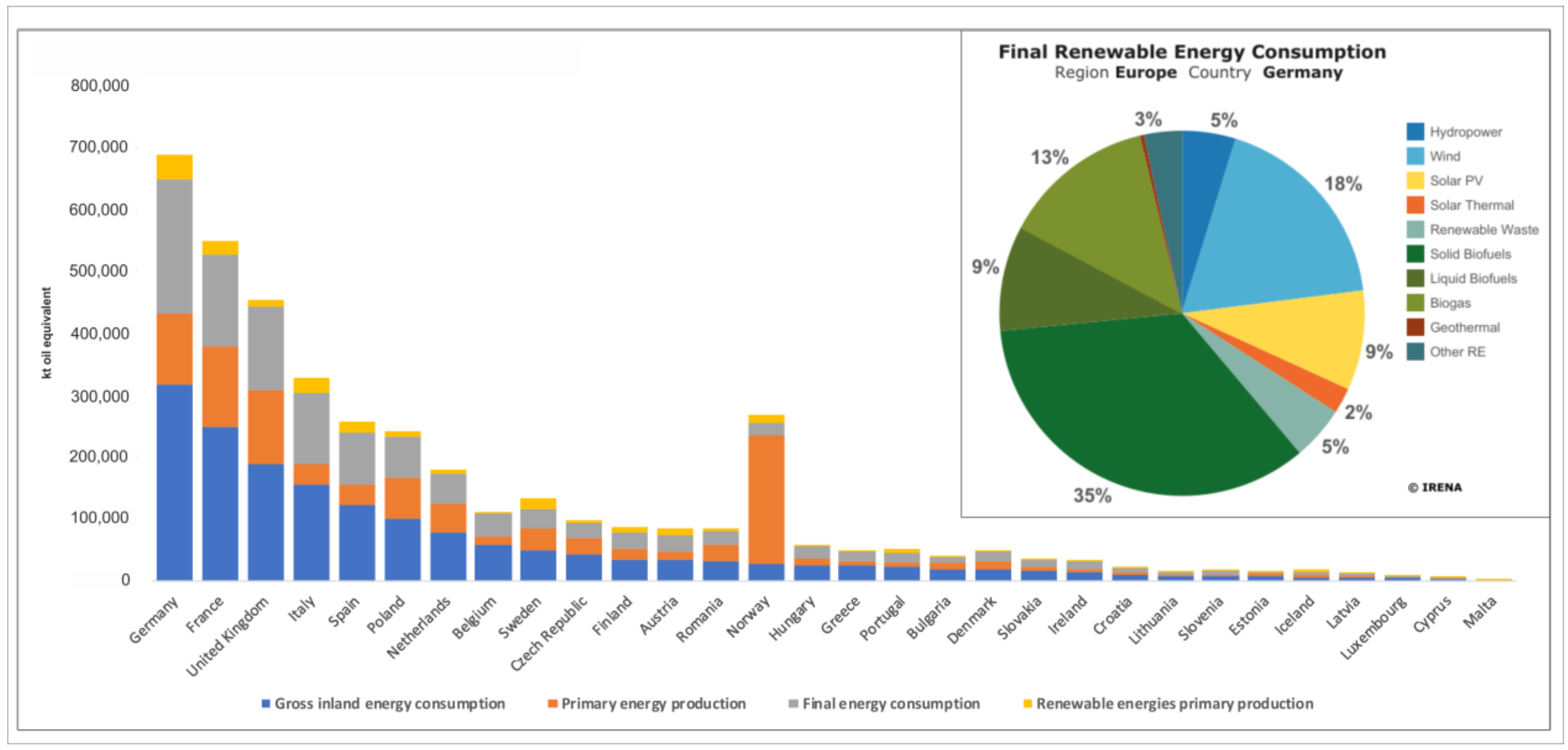

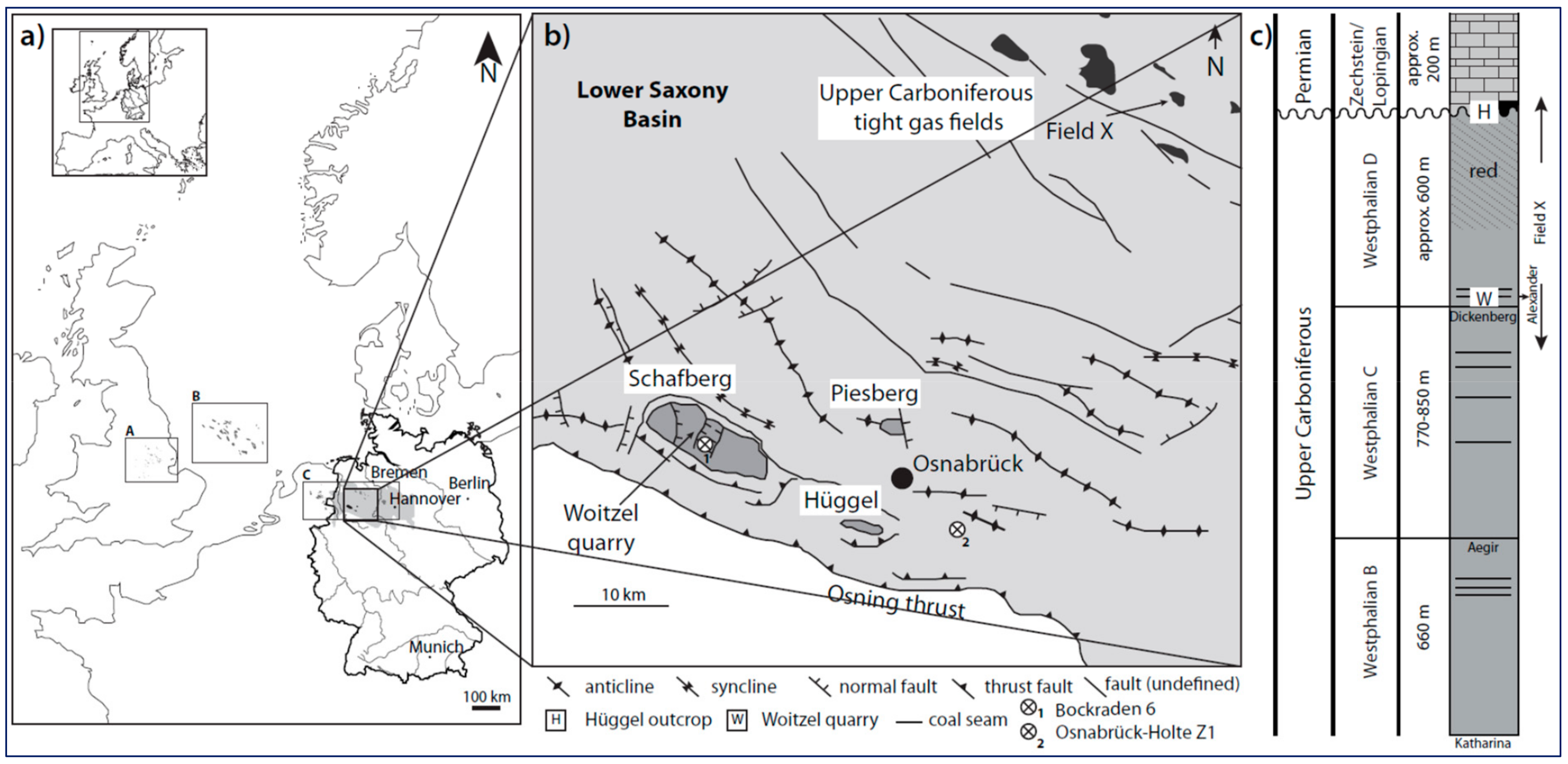
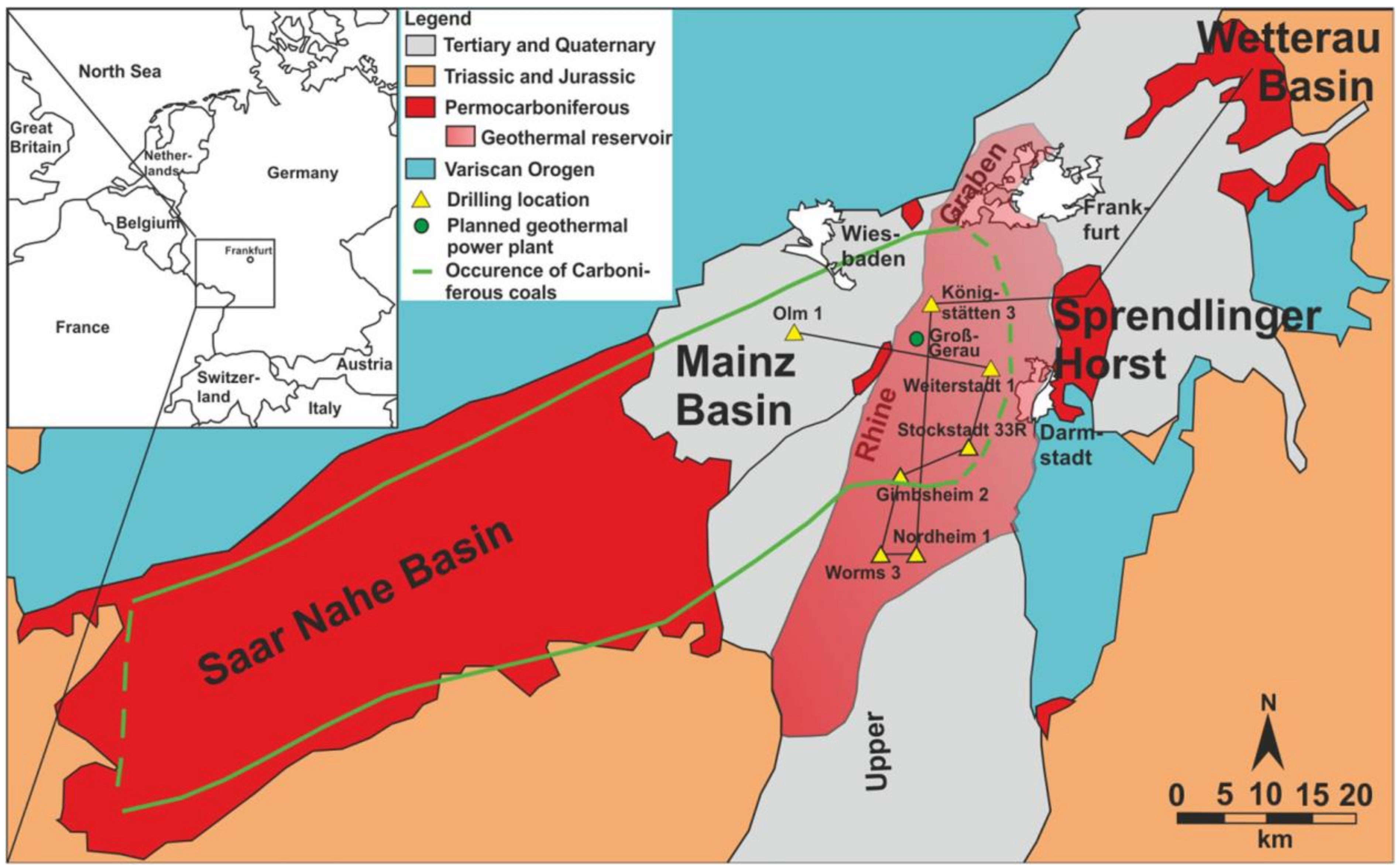
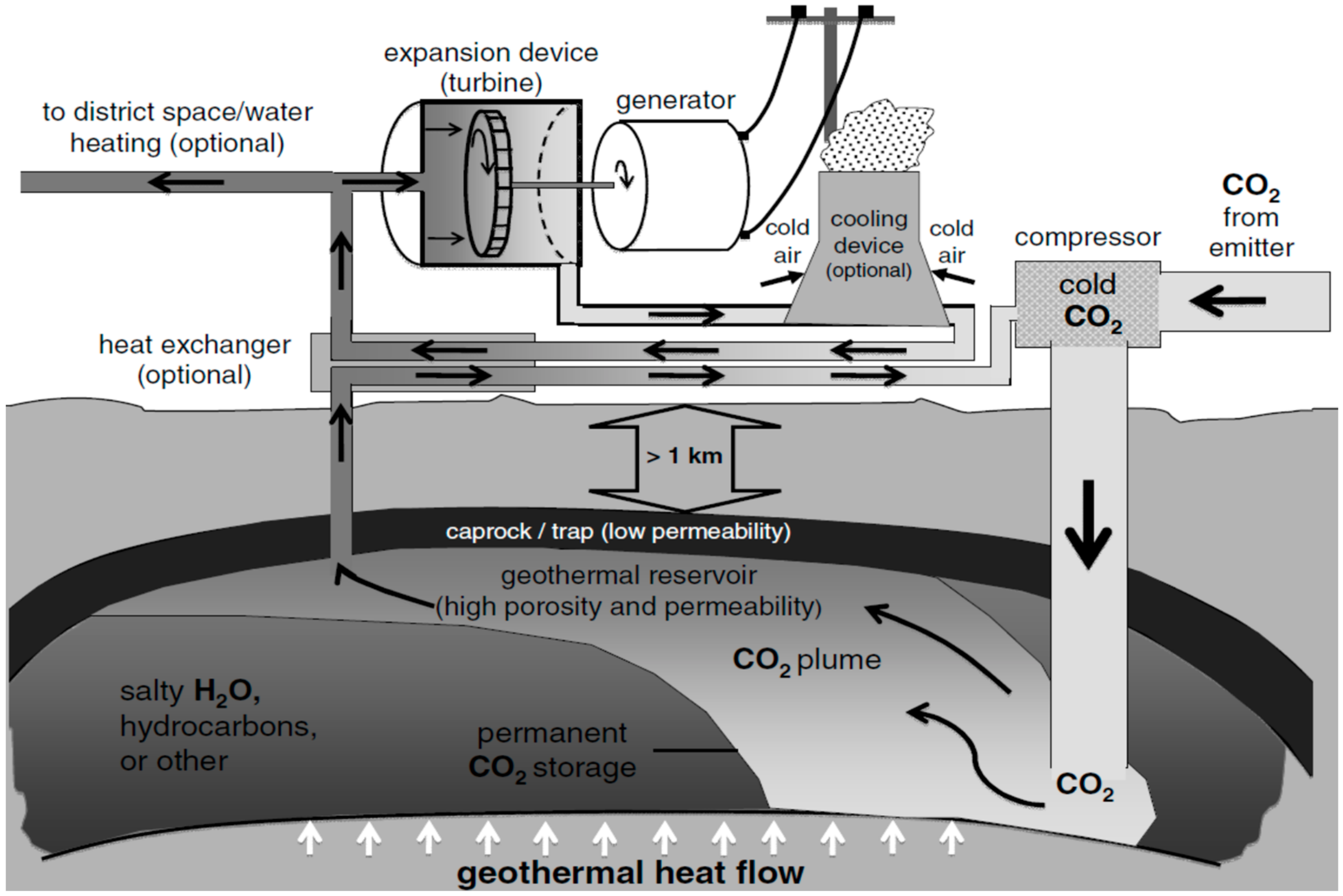
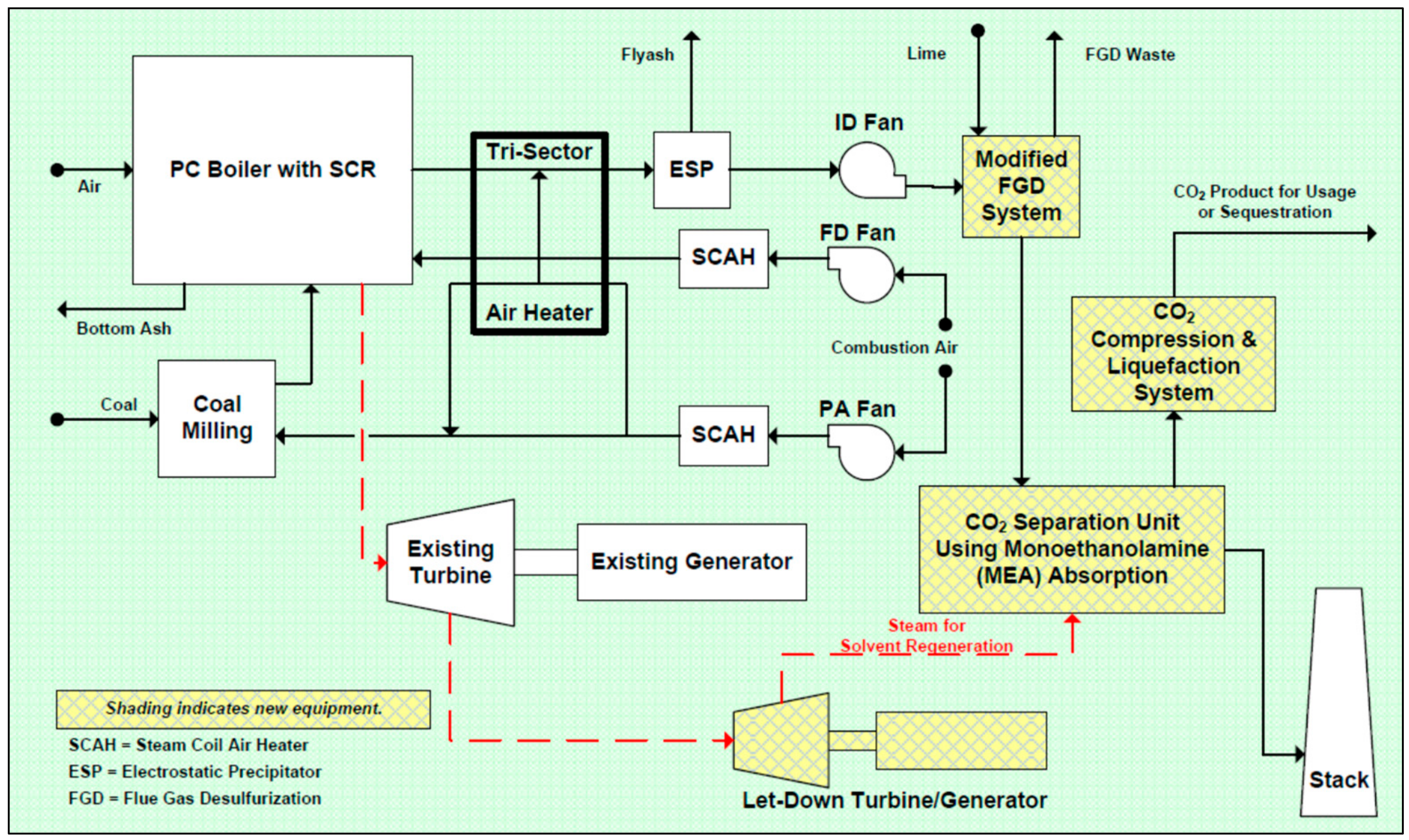
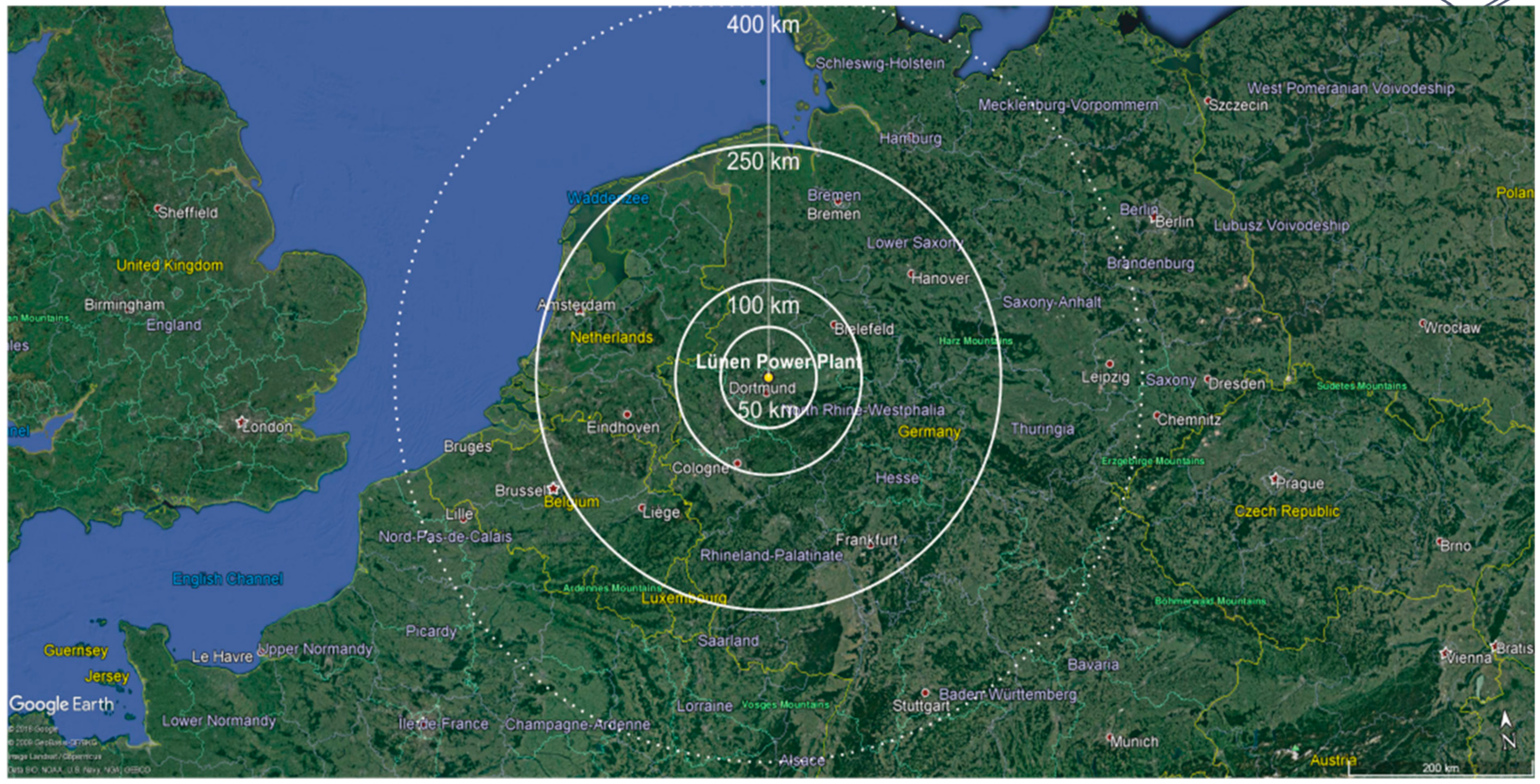
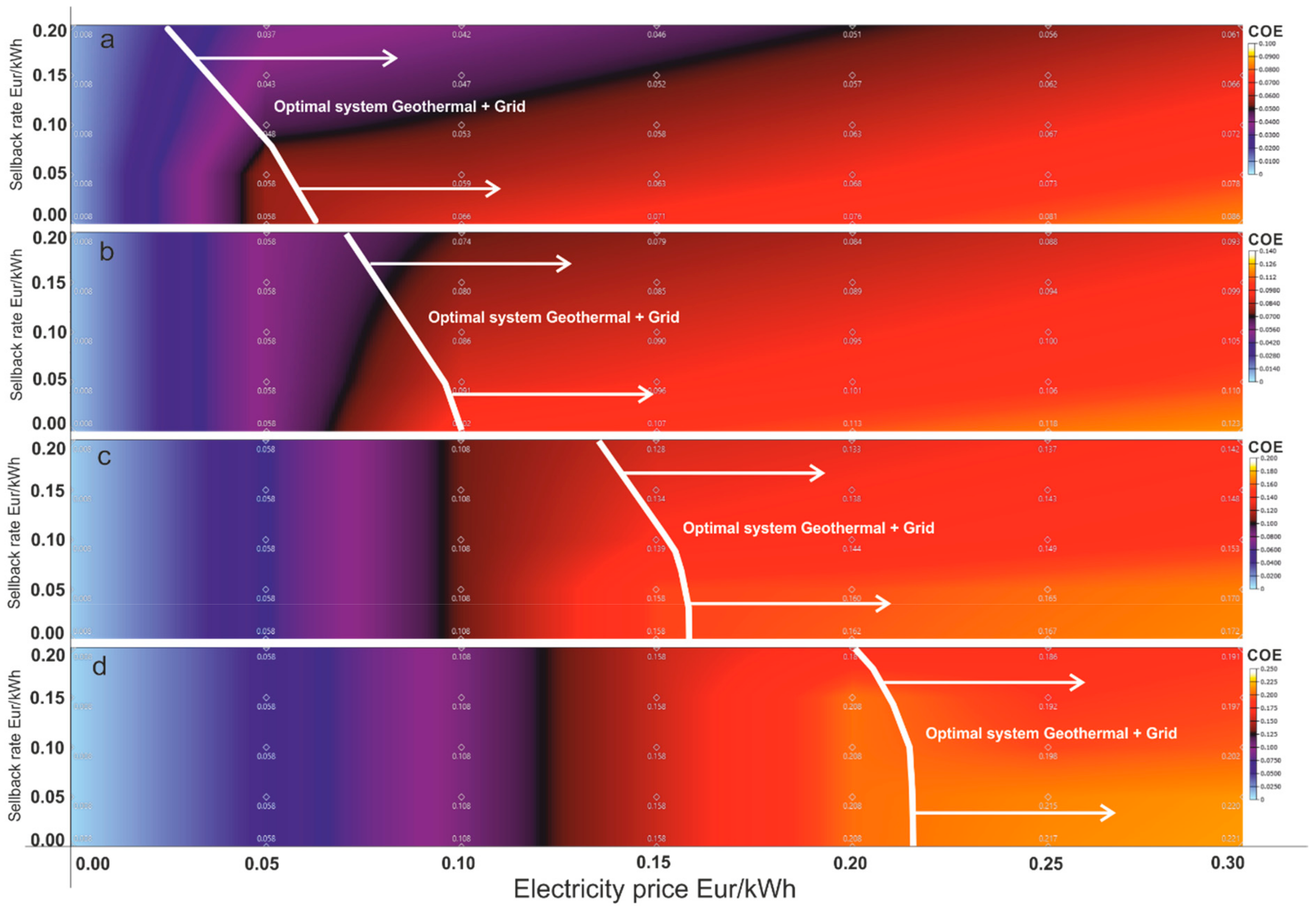
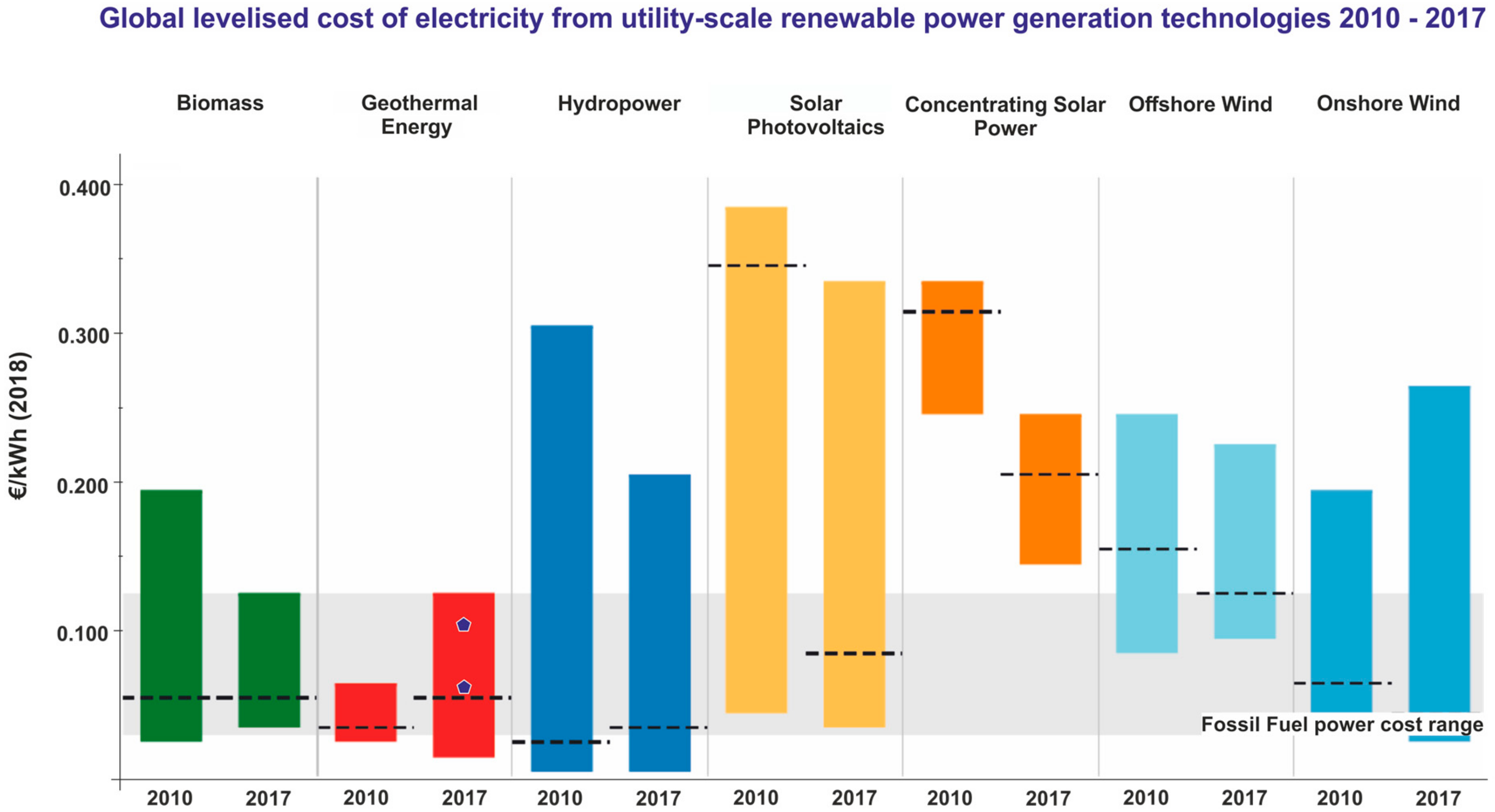

| Base Case Parameters | |||
|---|---|---|---|
| Geological formation | Injection/production conditions | ||
| Reservoir area | 3 km2 | Temperature of injected fluid | 15 °C |
| Thickness | 100 m | Injection/production rate | max. 300 kg/s (variable) |
| Well separation | 707 m | Injection rate | 126 kg/s |
| Permeability | 1.4 × 10−15 m2 | Downhole injection pressure | 31 MPa |
| Porosity | 15% (0.15) | Downhole production pressure | 30 MPa |
| Rock grain density | 2650 kg/m3 | Injection duration | 8 years |
| Rock specific heat | 1000 J/kg/°C | Production duration | 20–25 years |
| Thermal conductivity | 2.6 W/m/K | ||
| Formation initial conditions | Formation boundary conditions | ||
| Fluid in pore spaces | CO2/H2O | Top and sides | No fluid or heat flow |
| Temperature | 130 °C | Bottom | Heat conduction, no fluid flow |
| Pressure | 30 MPa | ||
| Motivator | Comments | Example Project |
|---|---|---|
| Enhanced Oil Recovery (EOR) | CO2 is used as a tertiary recovery agent to increase oil production in depleting or mature oil fields | see Table 3. |
| CO2 reduction targets | CO2 is stored in deep saline formations or depleted oil or gas fileds | see Table 3. |
| Enhanced Coal Bed Methane Recovery (CO2-ECBMR) and Enhanced Gas Recovery (EGR) | CO2 is used to enhance coal bed methane production from coal-beds or coal bearing formations or re-injected in suitable gas formations (depleted or for EGR) | see Table 3. |
| Use of CO2 for industrial purposes | CO2 is transported to greenhouses and used to stimulate growth of plants and crops | OCAP, Netherlands |
| Project Name | Type | Location | Start Year | Max. CO2 Injection Rate (t/Year) |
|---|---|---|---|---|
| Jilin oil filed | EOR | Jilin, China | 100,000 | |
| Weyburn-Midale | EOR | Saskatchewan, Canada | 2000 | 2,200,000 |
| Paradox Basin | EOR | Utah, USA | 2005 | 140,000 |
| Salt Creek | EOR | Wyoming, USA | 2006 | 2,200,000 |
| Williston Basin | EOR | North Dakota, USA | 2011 | 1,000,000 |
| South Heart | EOR | North Dakota, USA | 2012 | 600,000 |
| Oologah | EOR | Oklahoma, USA | 2012 | 1,500,000 |
| Masdar | EOR | Abu Dhabi, United Arab Emirates | 2012 | 1,700,000 |
| Hatfield | EOR | Hatfield, UK. | 2013 | 6,500,000 |
| California (DF2) | EOR | California, USA | 2014 | 5,000,000 |
| Mongstad | EOR | Mongstad, Norway | 2014 | 1,500,000 |
| Trailblazer | EOR | Texas, USA | 2014 | 4,300,000 |
| Greengen | EOR | China | 2015 | 700,000 |
| Genesee (EPCOR) | EOR | Alberta, Canada | 2015 | 3,600,000 |
| San Juan Basin | CO2-ECBM | New Mwxico, USA | 1996 | 100,000 |
| Permian Basin | CO2-ECBM | Texas, USA | 2005 | 300,000 |
| Farnham Dome/Uinta Basin | CO2-ECBM | Utah, USA | 2005 | 900,000 |
| Alberta Basin | CO2 storage | Alberta & B.C., Canada | 1990 | 100,000 |
| Mountaineer | CO2 storage | West Virginia, USA | 2009 | 100,000 |
| Brindisi | CO2 storage | Italy | 2012 | 1,200,000 |
| Sleipner | CO2 storage | North sea, Norway | 1996 | 1,000,000 |
| SnØhvit | CO2 storage | Barents sea, Norway | 2008 | 700,000 |
| Latrobe Valley | CO2 storage | Victoria, Australia | 2015 | 13,000,000 |
| Parameters | Value | Unit | Reference |
|---|---|---|---|
| Lifetime | 20 | years | |
| Germany electricity price | 30 | €/MWh | |
| Sellback rate | 20 | €/MWh | [3] |
| Pulverized Coal Power Plant | |||
| PP size | 750 | MW | [89] |
| Operation | 7800 | h/year | |
| Production | 5,850,000,000 | kWh/year | |
| Coal consumption | 1,500,000 | t/year | |
| Coal price | 93.5 | €/t | |
| CO2 amount | 4,500,000 | t/year | |
| Capture Ratio | 90 | % | [45] |
| CO2 to Capture | 4,050,000 | t/year | |
| CO2 emitted (calculated) | 0.769230769 | kg CO2/kWh | |
| CO2 emitted (reference) | 0.75 | kg CO2/kWh | [43,89] |
| Power Plant cost | 1,400,000,000 | € | [89] |
| Operation and Maintenance | 140,250,000 | €/year | |
| CO2 penalty | 100 | €/t CO2 | [47] |
| CO2 penalty | 450,000,000 | €/year | |
| Capture cost | 32 | €/t CO2 | [45] |
| Total Capture cost | 116,640,000 | €/year | |
| Pipeline | |||
| Length | 100 | km | |
| Transportation capacity | 50 | 106 t/year | [88] |
| Transportation cost | 0.02 | €/t CO2/km | [44] |
| Transportation cost | 7,290,000 | €/year | [44] |
| Exploration and drilling | |||
| Drilling cost | 6,653,800 | € | [96] |
| Exploration cost | 1,330,760 | € | [98] |
| Number of wells | 2 | ||
| Exploration and drilling cost | 14,638,360 | € | [96] |
| Reservoir | |||
| Depth | 3000 | m | [32,49] |
| Temperature | 130 | °C | [32,49] |
| Area | 3 | km2 | [32,49] |
| Thickness | 100 | m | [32,49] |
| Volume | 0.3 | km3 | |
| CO2 density | 560 | kg/m3 | [24] |
| Fluid loss | 5 | % | [22] |
| Geothermal Power Plant | |||
| Size | 50 | MW | [16,20] |
| Electricity output | 6.5 | MW | [16,20] |
| Thermal output | 28 | MW | [16,20] |
| Electricity Generation (potential) | 56,200 | MWh/year | |
| Thermal energy generation (potential) | 248,000 | MWh/year | |
| Construction and machinery | 41,522,500 | € | [68] |
| Operation and Maintenance | 504 | h | [68] |
| O&M | 800 | €/hour | |
| 403,200 | €/year | [68] | |
| Grants | 2,000,000 | € | [3,28] |
| TOTAL PROJECT COST | 54,160,860 | € |
© 2020 by the authors. Licensee MDPI, Basel, Switzerland. This article is an open access article distributed under the terms and conditions of the Creative Commons Attribution (CC BY) license (http://creativecommons.org/licenses/by/4.0/).
Share and Cite
McDonnell, K.; Molnár, L.; Harty, M.; Murphy, F. Feasibility Study of Carbon Dioxide Plume Geothermal Systems in Germany−Utilising Carbon Dioxide for Energy. Energies 2020, 13, 2416. https://doi.org/10.3390/en13102416
McDonnell K, Molnár L, Harty M, Murphy F. Feasibility Study of Carbon Dioxide Plume Geothermal Systems in Germany−Utilising Carbon Dioxide for Energy. Energies. 2020; 13(10):2416. https://doi.org/10.3390/en13102416
Chicago/Turabian StyleMcDonnell, Kevin, Levente Molnár, Mary Harty, and Fionnuala Murphy. 2020. "Feasibility Study of Carbon Dioxide Plume Geothermal Systems in Germany−Utilising Carbon Dioxide for Energy" Energies 13, no. 10: 2416. https://doi.org/10.3390/en13102416
APA StyleMcDonnell, K., Molnár, L., Harty, M., & Murphy, F. (2020). Feasibility Study of Carbon Dioxide Plume Geothermal Systems in Germany−Utilising Carbon Dioxide for Energy. Energies, 13(10), 2416. https://doi.org/10.3390/en13102416







